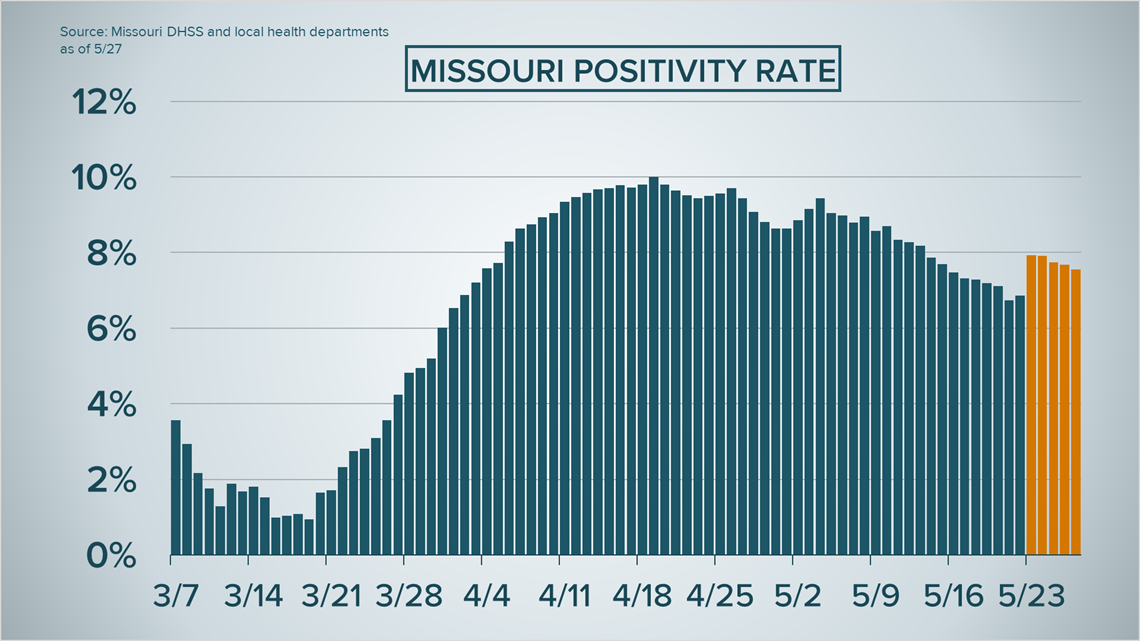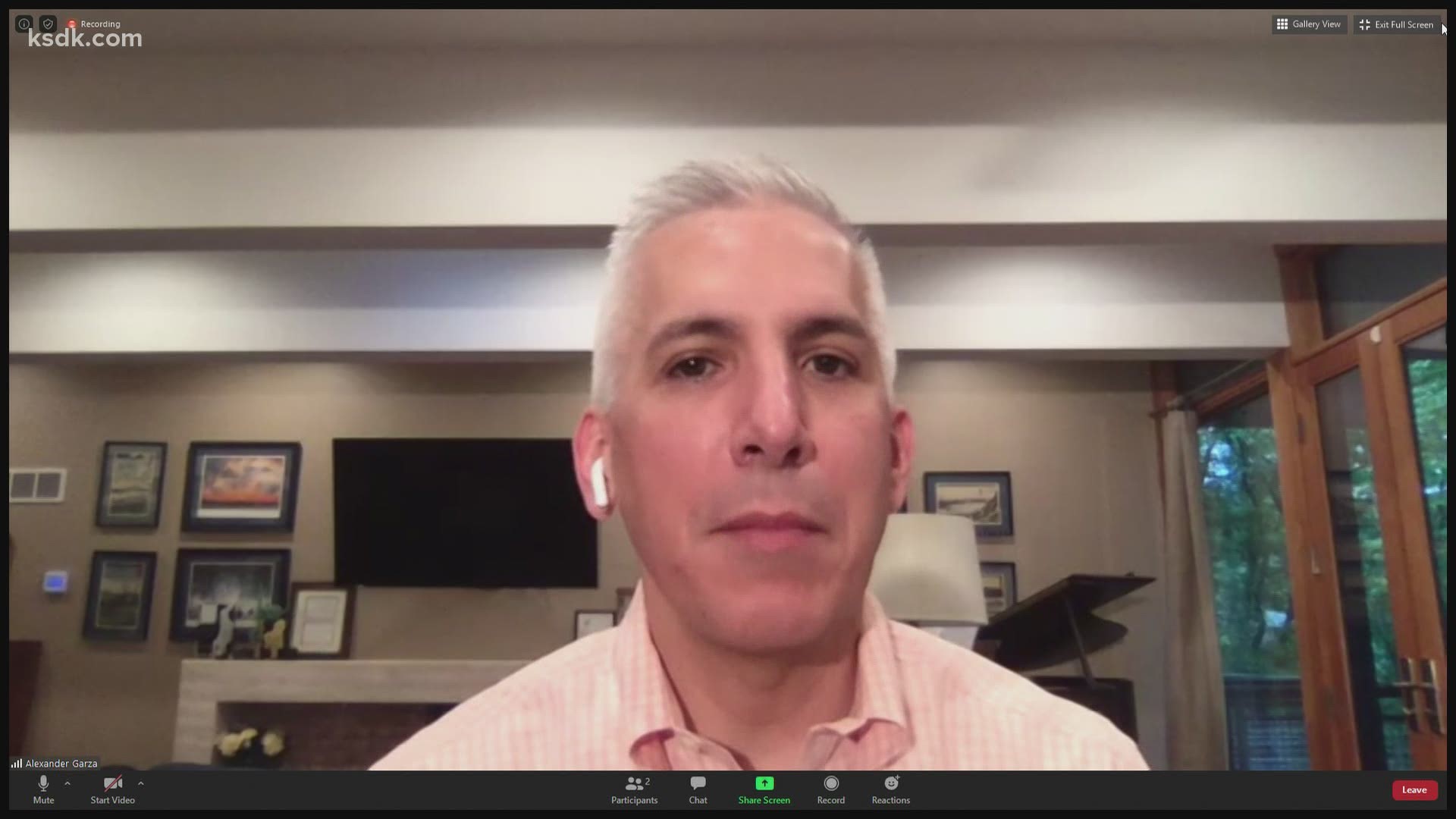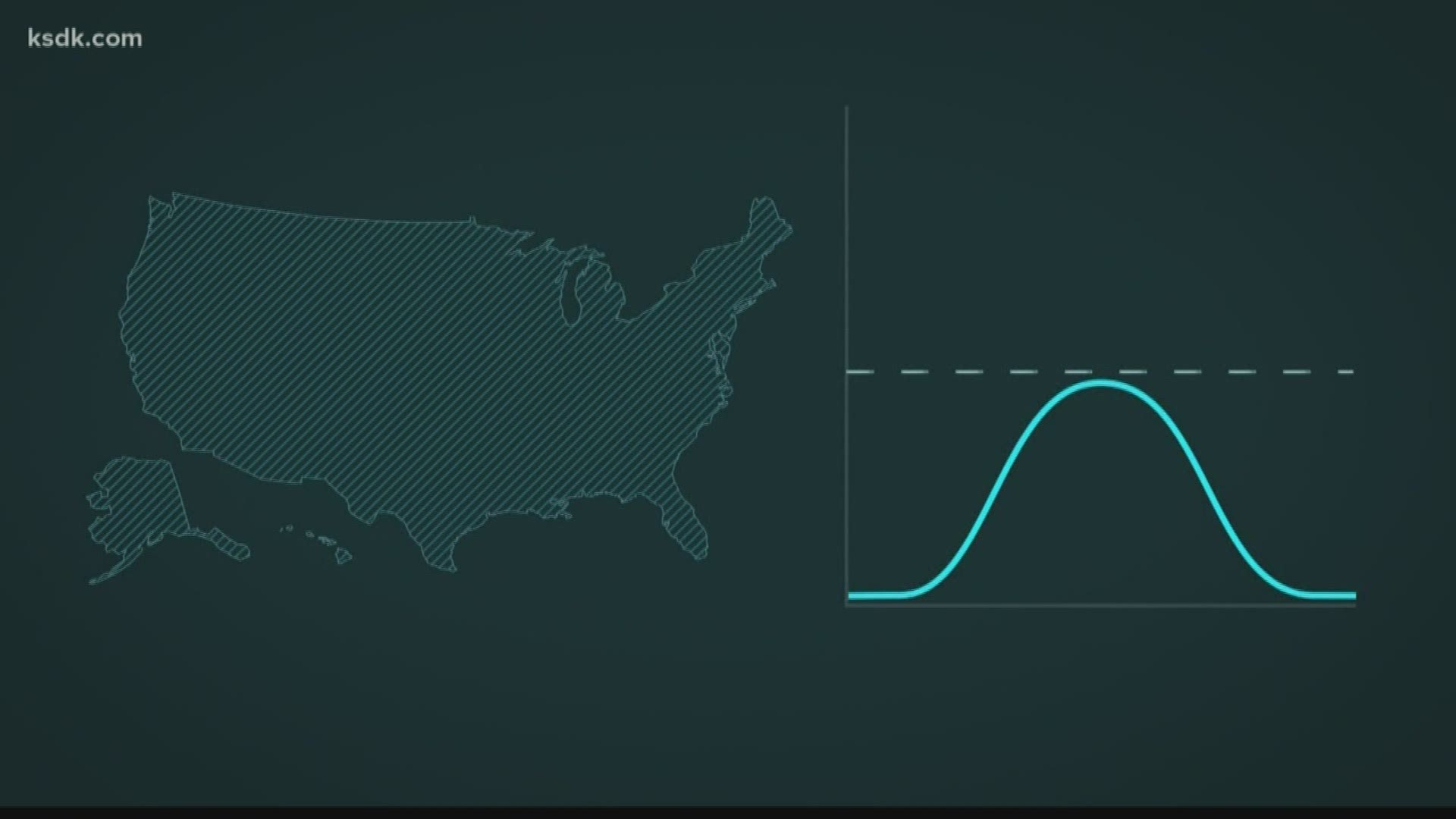ST. LOUIS — Concerns over the coronavirus, officially named COVID-19, are growing in the St. Louis area.
5 On Your Side is focusing on giving you facts and not spreading fear. We’ve gathered up the latest information you need to know about the virus, which we’ll continue to update as new information comes in.
Coronavirus questions: We're working to get your questions answered by local health officials. You can see the growing list of questions answers by clicking here. We're adding new answers every weekday.
We've added a newscast at 10 a.m. weekdays to answer your questions and share the latest updates. We're dedicated to keeping St. Louis informed and healthy. Take care of yourself and each other and if you have any questions about this health emergency text our team at 314-444-5125.
Follow our latest coronavirus coverage at KSDK.com/coronavirus and on the 5 On Your Side app.
Latest Coronavirus Headlines:
- President Trump says he's been taking malaria drug to protect against COVID-19
- Nursing homes should be virus-free for 28 days before opening, feds warn
- You can now call the IRS with your stimulus check questions
- No virtual Republican National Convention, GOP chair vows
- Moderna: Early COVID-19 vaccine results are encouraging
- Uber cuts 3,000 more jobs as virus slashes its workforce by 25%
- Some restaurants may be adding a COVID surcharge to your bill
Helpful Links
- Your top coronavirus stimulus check questions answered
- Stimulus check calculator: See how much you'll likely be getting
- YES! Social Security and disability recipients will get stimulus checks
- How to make sure you actually get your coronavirus stimulus check
- How to file for unemployment during the coronavirus pandemic
- Should you wear gloves out in public? Doctors say no. Here's why.
- The mistake you're probably making with your face mask
- The material you should be using for your DIY face mask
- St. Louis extends earnings tax filing deadline to July 15, mirroring federal and state extensions
- What is a stay-at-home order?
- These places are hiring temporary workers as coronavirus increases demands
- Can coronavirus spread on mail? United States Postal Service issues statement
Cases in Missouri:
The Missouri Department of Health and Senior Services reported a total of 12,962 cases and 771 deaths Wednesday, an increase of 201 cases and 10 deaths. The state also reported a total of 193,380 PCR tests.
The single-day case increases over the last week were:
- 164 last Saturday
- 128 last Sunday
- 109 on Monday
- 91 on Tuesday
- 136 on Wednesday
- 168 on Thursday
The positivity rate in the state decreased to 7.56% Tuesday, down from 7.68% on Monday. The rate has dropped each day since the state made changes to the way it reports testing data.
RELATED: Missouri health department reports 1 new death as director takes questions on reporting change


The Missouri DHSS COVID-19 count did not include about 300 cases and six deaths reported by St. Louis area health departments, bringing the totals to 12,827 cases and 702 deaths in the state. Local health departments typically have more up-to-date information than the state. Five of the deaths reported by the Missouri DHSS Wednesday were previously reported by St. Louis area health departments.
St. Louis and St. Louis County account for more than half of the cases and deaths in the state. St. Louis County has the highest number of cases(4,832) and deaths(389) of any county in the state, but St. Louis city has a higher rate of cases.
St. Louis has the highest rate of COVID-19 in the area with 626 per 100,000, but there are three counties in the state with higher rates. Saline County has the highest with 1,173 per 100,000 followed by Sullivan at 870 and Buchanan with 757.
The age breakdown for state-reported cases as of Wednesday was:
- Under 20 481
- 20-24 773
- 25-29 948
- 30-34 881
- 35-39 856
- 40-44 871
- 45-49 995
- 50-54 1037
- 55-59 1104
- 60-64 1063
- 65-69 815
- 70-74 676
- 75-79 526
- 80+ 1426
The age breakdown for state-reported deaths as of Wednesday was:
- Under 20 0
- 20-29 1
- 30-39 4
- 40-49 13
- 50-59 44
- 60-69 117
- 70-79 183
- 80+ 334
How COVID-19 is affecting our area
- 'The virus hasn't left' | St. Louis doctors say social distancing measures need to continue as cities reopen
- Washington University leads global COVID-19 treatment study for health care workers
- Gym owners to meet with St. Louis County about possible reopening plan
- A look inside St. Louis area restaurants, salons and stores as they reopen
- ‘We cannot look at this as a victory or a celebration, too many lives have been lost’ | St. Louis County Executive on first day of reopening
- How to avoid job scams targeting people unemployed due to COVID-19
- Parking enforcement to resume in St. Louis on June 1
St. Louis County
On May 27, St. Louis County reported an increase of 66 cases and two deaths, bringing the county's totals to 4,832 cases and 387 deaths.
That's the most of any county in Missouri.
On Monday, St. Louis County allowed some businesses to reopen with new rules to help limit the spread of the coronavirus.
St. Louis
The City of St. Louis reported 17 new cases and one additional death on May 27, bringing the totals to 1,884 cases and 117 deaths.
On Monday, St. Louis joined St. Louis County in allowing some businesses to reopen their doors to customers.
St. Charles County
St. Charles County has 755 cases as of May 27, including 55 deaths. The county reported seven new cases and one new death Monday.
St. Charles County began reopening its economy on May 4.
RELATED: What reopening looks like: Scenes from St. Charles as restaurants, retailers get back to work
Jefferson County
On May 27, the Jefferson County Health Department reported one new case and no deaths. There have been 345 confirmed positive cases of COVID-19 in the county. Sixteen have resulted in death.
Jefferson County began reopening its economy on May 4.
Franklin County
Franklin County's COVID-19 total stands at 140, including 16 deaths, as of May 27, with one new case over the last 24 hours. On May 23, the county said it had 18 active positive cases and 104 people have fully recovered. They range in age from 19 to 98 years old.
The impact on other Missouri counties in the St. Louis area has been limited.
You can see a county-by-county breakdown with the interactive map below.
The map reports the higher number of confirmed cases for each local county as confirmed by the state or local health department. The numbers from county health department officials may not match the state count.
Cases in Illinois:
There have been 118,917 total confirmed COVID-19 cases and 5,330 deaths as of May 31, according to the Illinois Department of Public Health. A total of 877,105 tests have been performed.
RELATED: This graph shows why Illinois' largest single-day increase in COVID-19 cases isn't as bad as it seems
May 5, Gov. Pritzker announced a five-phase, regional plan for reopening the state. On May 22, he said the entire state would be allowed to move to Phase 3 on May 29.
On April 25, Gov. Pritzker and Dr. Ngozi Ezike with the Illinois Department of Public Health cautioned against the ingesting, injecting or snorting of household cleaners, citing an increased amount of calls to the Illinois Poison Center.
The large increase in cases on Friday was due to the state administering its largest number of tests, officials said. Gov. JB Pritzker said the state met its goal of 10,000 COVID-19 tests per day.
"Testing is really key to everything else we need to do, to get Illinois moving again," he said.
Patients have ranged in age from younger than 1 to 99 years old, the Illinois Department of Public Health said.
Most of the cases and deaths have been in the Chicago area.
IDPH said the number of COVID-19 cases being reported is rising quickly partly because testing is becoming easier, but also because the virus is spreading across communities.
On April 23, Gov. Pritzker extended the stay-at-home order for Illinois through May 30. The new order also requires people over the age of 2 to wear facemasks when going out in public.
On April 17, he announced students will stay home from school through the rest of the school year.
On April 2, the state launched a new statewide initiative called “All in Illinois” to reinforce the state’s message during the coronavirus pandemic: stay home and stay safe.
As Illinois residents practice social distancing, the initiative is a way to “unite residents across the state and remind them we are all in this together.”
How COVID-19 is affecting our area
- St. Clair County part of new effort to increase contact tracing in Illinois
- Report: Illinois unemployment system 'glitch' publicized private data
- Collinsville High School gives memorable graduation with drive-thru diploma ceremony
- Madison County businesses begin to reopen, but with criticism
- Illinois extends stay-at-home order through May 30, requires masks in public
The state has issued a disaster proclamation. Gov. Pritzker called the proclamation an "operational procedure" that opens up Illinois to receive more state and federal resources and tools in how it handles coronavirus cases. The proclamation also would allow Illinois to be eligible to receive federal reimbursement.
On March 25, Gov. Pritzker announced the state would delay its tax filing date to July 15, which is the same date the federal tax deadline was moved to. He also announced two new loan programs for small businesses.
He also announced a new initiative, Illinois COVID-19 Response Fund, that will support nonprofits across the state. Gov. Pritzker said about $23 million has been raised for the fund so far. If you’d like to donate to the fund, click here.
On March 27, Gov. Pritzker announced more than 500 former medical professionals have submitted applications to come back to work to support the state’s coronavirus response.
Metro East
The county-by-county numbers in the Metro East as of May 21 were:
- Bond County 10 cases, 1 death
- Calhoun County 1 case, 0 deaths
- Clay County 2 cases, 0 deaths
- Clinton County 178 cases, 16 deaths
- Fayette County 20 cases, 3 deaths
- Greene County 5 cases, 0 deaths
- Jersey County 20 cases, 1 death
- Macoupin County 43 cases, 1 death
- Madison County 551 cases, 58 deaths
- Marion County 50 cases, 0 deaths
- Monroe County 93 cases, 11 deaths
- Montgomery County 39 cases, 1 death
- Randolph County 264 cases, 4 deaths
- St. Clair County 1134 cases, 89 deaths
- Washington County 18 cases, 0 deaths
Many of the deaths in the Metro East have been residents of nursing homes and long-term care facilities.
On May 12, the Madison County Board voted to reopen the county despite the statewide stay-at-home order.
Cases in the U.S.:
The CDC said more than 99,031 people have died from COVID-19 in the United States and 1,678,843 people have tested positive as of May 27, an increase of 770 deaths and 16,429 cases over the last 24 hours. According to numbers from Johns Hopkins University, more than 391,508 people have recovered from COVID-19.
On Wednesday, the count from Johns Hopkins, which updates in real-time, reported the death toll in the United States surpassed 100,000.
RELATED: US reaches 100,000 COVID-19 deaths
On April 24, President Donald Trump signed a $484 billion bill to aid employers and hospitals under stress from the coronavirus pandemic. It's the latest effort from the federal government to keep businesses afloat.
On March 27, President Donald Trump signed an unprecedented $2.2 trillion economic rescue package into law, after swift and near-unanimous action by Congress this week. The package will support businesses, rush resources to overburdened health care providers and help struggling families during the deepening coronavirus epidemic. As he signed the bill Friday, Trump declared it “will deliver urgently needed relief.” He thanked members of both parties for putting Americans “first.”
Cases around the world:
The World Health Organization said there are 5,491,678 confirmed cases and more than 349,000 deaths as of May 27. According to Johns Hopkins data, more than 2,350,000 people have recovered.
On March 26, the United States surpassed China as having the most confirmed cases, according to the interactive map shown below from Johns Hopkins. The U.S. is followed by Spain, Italy, France, Germany and China. The map tracks the numbers in real-time.
On April 2, the worldwide count according to Hopkins passed the 1,000,000 mark.
The CDC has given a global Warning Level 3 travel notice due to widespread transmission of COVID-19. A Level 3 warning means all nonessential travel should be avoided. The CDC is also advising against cruise ship travel worldwide.
Frequently asked questions:
What is a coronavirus?
According to the World Health Organization, coronaviruses are a large family of viruses that cause illnesses ranging from the common cold to more severe diseases including Severe Acute Respiratory Syndrome (SARS) and Middle East Respiratory Syndrome (MERS).
What are the symptoms of COVID-19?
According to the CDC, patients diagnosed with this coronavirus experience a mild to severe respiratory illness. Symptoms include fever, cough and shortness of breath. Patients with severe complications from the virus often develop pneumonia in both lungs.
How does the virus spread?
The virus is spread person-to-person. According to the CDC, spread is happening mainly between people who are in close contact (within 6 feet) of each other via respiratory droplets produced when an infected person coughs or sneezes. The droplets land on the noses and mouths of other people, who then inhale them.
The CDC says it may be possible for the virus to spread by touching a surface or object with the virus and then a person touching their mouth, nose or eyes, but this is not thought to be the main method of spread. As the virus was discovered just a few months ago, more research is required to learn more about the spread pattern of the virus.
How do I protect myself and others?
There is currently no vaccine to prevent COVID-19 or medication to directly treat COVID-19. Therefore, the best way to protect yourself is to avoid being exposed to the virus that causes COVID-19. The CDC recommends maintaining personal preventative actions such as:
- Avoiding close contact with those who are sick
- Not touching your eyes, mouth or nose, especially with unwashed hands
- Washing your hands often with soap and warm water for last least 20 seconds
- Clean and disinfect objects and surfaces that are frequently touched
- Stay home if you are sick
- Cover your coughs and sneezes with a tissue
There also is no need for members of the general public to wear surgical masks to guard against coronavirus. Individuals should only wear a mask if a healthcare professional recommends it.
Is there a cure for the virus?
There is currently no vaccine to protect against COVID-19. Once infected, there is not an antiviral treatment available for COVID-19. People should take care to avoid being exposed to the virus and seek medical care to relieve symptoms if infected with the virus.


